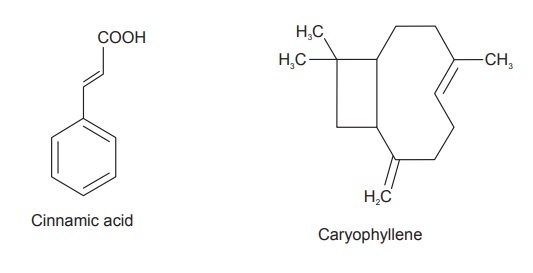Cassia Bark
| Home | | Pharmacognosy |Chapter: Pharmacognosy and Phytochemistry : Drugs Containing Volatile Oils
Cassia is the dried stem bark of Cinnamomum cassia Blume., belonging to family Lauraceae.
CASSIA BARK
Synonym
Chinese cinnamon, Cassia
lignea, Bastard cinnamon, Cassia aromaticum, Canton cassia.
Biological Source
Cassia is the dried stem bark of Cinnamomum cassia Blume., belonging to family Lauraceae.
Geographical Source
It is Indigenous to China, Cochin and Assam. It is also
cultivated in Ceylon, Japan, Sumatra, Java, Mexico, and America.
Cultivation
The collection is done from cultivated plants. The trees are
allowed to grow for 6 years and then the branches which are about 3 cm thick
and 40 cm long are cut. The twigs and leaves are stripped off, then two
longitudinal slits and three to four transverse ring cuts are made. The barks
are stripped off. Then cork and some parts of outer cortex are peeled off by
running a small plane over it. The bark is then dried, packed in bundles of 30
to 40 cm long weigh-ing half kg and exported.
Characteristics
The barks are either channelled pieces or as single quills;
the size of drug ranging from 6 to 40 cm long, 1 to 2 cm in width, and 1 to 3
mm in thickness. The fractures are short. The outer surface is dark
reddish-brown, smooth with rather rough patches of grey cork. The inner,
surface has fine striations. The flavour is more pungent, less sweet, and delicate
and slightly bitter than that of cinnamon. The bark may be distinguished from
that of cinnamon, because they are thicker, coarser, darker, and dull.
Microscopy
Periderm is the outer layer; cork consists of few layers of
both thin-walled and thick-walled cells. The inner thick-walled cells are
lignified. Cortex consists of 10 to 15 layers of parenchyma with sclereids
isolated or in groups and starch grains. A well-developed belt of sclereids
occur between the primary and secondary phloem. Cassia has the lignified and
pitted sclereids as its characteristic feature. The secondary phloem consist of
phloem parenchyma which is thin-walled, containing abundant starch; isolated or
group of phloem fibres embedded in phloem parenchyma and one- to three-celled
medullary rays consisting of the starch and acicular raphides.
Chemical Constituents
Cassia bark yields 1 to 2% of volatile oil. It also has
about 80 % cinnamyl acetate, cinnamic
acid, caryophyllene, phenylpropyl acetate, orthocumaric aldehyde, coumarin,
tannic acid, and starch. Eugenol is absent. The value of the drug depends on
the percentage of cinnamic aldehyde present in it.

Uses
Cassia is used as carminative, mildly astringent, stomachic,
decreasing the milk secretion, and emmenagogue. It is used in uterine
haemorrhage, menorrhagia, diarrhoea, nausea, and vomiting. The Cassia oil is a
powerful germicide, local stimulant also prescribed in flatulent colic and
gastric debility.
Chemical Test
1. Cassia gives a deep blue black
colour when a drop of tincture of iodine is mixed with fluid ounce of a
decoction of the powder.
2. The cheaper Cassia can be
distinguished by the greater quantity of mucilage present, which can be
extracted by cold water.
3. Cassia oil contains coumarin which
gives strong green-blue fluorescence on addition of alkali.
Other Species
Cassia burmanii Blume or the Java or Batavia
cinnamon; they have a slightly
aromatic odour and aromatic and mucilaginous taste; it can be distinguished by
the presence of tabular crystals of calcium oxalate which are not found in
other cinnamon barks. C. inners, C.
lignea, C. sintok, C. obtusifolium,
C. culilawan, C. loureirii, C. pauciflorum, C. inserta, C. nitidum are some
of the commonly available species of cinnamon.
Marketed Products
It is one of the ingredients of the preparations known as
Diakof, Koflex, Abana (Himalaya Drug Company), Shukra Matrika Bati
(Baidyanath), and Madhudoshantak (Jamuna Pharma).
